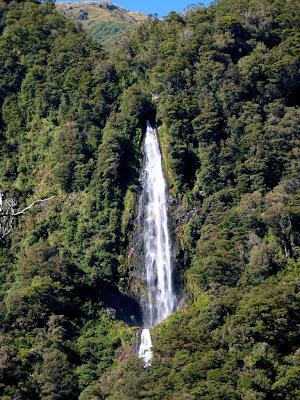It is a fact -- we are not the most spontaneous of people. We have a route, we plan our meals, and we know which campgrounds are on the way. So when John says "I have a wild hair...", I know this cruise ship of a journey is going to make a quick change in course. And I get all fluttery excited.
When reached the town of Wanaka after crossing from the remoteness of the West Coast, it was filled with advertising and camper vans and tourists lying in the sun on the lakeshore. The weather forecast was not looking good for the next week, and our plan was to head to Queenstown for some tramping in the mountains. But stories of how busy it gets there over Christmas and the prospect of sitting out weather in an expensive town was not attractive. So we headed east.
Central Otago is the region east of the Southern Alps, in the rain shadow of those tall mountains. It is open, dry, and warm. And making a large arc is the
Central Otago Rail Trail, a former railway that has been converted to a walking and bicycle trail. The route goes through towns and intersects the paved road on occasion, but the gravel route generally passes through sparsely populated farmland and wide open country with big skies that made us feel like we were home.
 |
| Our first day was filled with sun and puffy clouds. |
 |
| The rivers in this dry region flow slowly, especially with the recent drought. |
 |
| The rails have been removed along the route, and bridges planked for smooth crossings. |
 |
| Former station locations have been converted to information shelters, a true 'outdoor museum". |
 |
| Passing through cuts made in the rock, necessary to maintain an gentle grade, gave us the sense that those old steam engines weren't all that big. |
 |
| We spent two nights at the Omakau Recreation Reserve, an excellent domain facility. There we met George, a fellow bike tourist, and we spent the time sharing experiences and the Sunday paper. |
 |
| Fireplaces are all that remain from the railway construction camp from the early 1900's. |
 |
| Entering one of four tunnels along the route. |
 |
| The bridges are most impressive because of the hand-hewn rock. |
 |
| Big sky country, Kiwi style. |
 |
| Near the high point on the trail, the Wedderburn station was the smallest staffed station at the time it was operating. It wasn't more than a big lean-to. |
 |
| Our last night on the trail was a stealth camp next to a creek, providing shade and coolness on a hot day. Please forgive us for violating the 100-foot rule. |
 |
| Laundry hanging at our creekside campsite. |
We did not complete the entire length of the 150 kilometer trail, but rather exited at Ranfurly to take a more direct route to the coast over
Dansey's Pass. We knew at least it was a gravel road in good condition, and there were no great negative reactions when we told locals of our intent, so that was enough to satisfy the planning need within us.
But what we could not control was the wind -- gusty and strong that whipped up dust and nearly knocked us off our bikes. We met two other German cyclists coming down, and they were nearly in shock from the struggle. We only had to fight it for about 15 kilometers, and we camped in a dense pine forest near the base of the pass. Our campsite was so protected we felt barely a breeze, even though we heard it swishing thorough the treetops above us throughout the night.
 |
| Approaching the pass outside of the cute town of Naseby. |
 |
| Miles from nowhere, you can still get most anything you need. |
 |
| Our wooded campsite, in a forest of pines planted by the miners that worked in this area over a century ago. |
The next morning we set out for the pass after morning rain shower. The skies cleared, but the wind persisted. Fortunately, it was to our backs, so at times it felt like a gentle hand was pushing us when we needed it the most.
 |
| A steady and even grade to the pass. |
 |
| Tussocky slopes looking southwest from Dansey's Pass, with a view of the ocean in the distance. |
The downhill was fine until we reached a section of road that was freshly graded. No longer packed by passing cars, the road surface was difficult to navigate. At one point I got going a bit too fast, and braking just caused my bike to fishtail. Next thing I knew, I did a slide into homebase, panniers strewn on the road, but with only a scraped and bleeding elbow as a result. We proceeded a bit more carefully after that, until reaching the flat and paved road in the valley.
 |
| Looking back from where we came during our cautious descent, despite the approaching threat of rain. |
|
.





















































